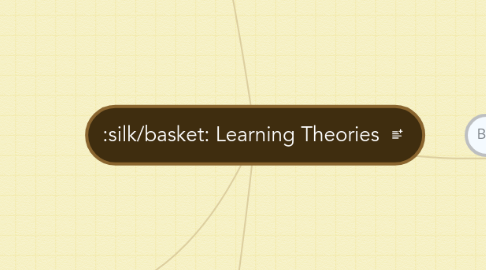
1. Cognitivism
1.1. Mind as an information processor
1.2. Mind representations and mental models
1.2.1. Short-term Memory (STM)
1.2.1.1. Attention
1.2.1.1.1. catch attention
1.2.1.1.2. limited capacity
1.2.2. Long-term Memory (LTM)
1.2.2.1. information stored in the LTM is stored semantically
1.2.2.1.1. in terms of meanings/concepts
1.2.3. working memory
1.2.3.1. contains information a learner is working on
1.2.3.2. permanence about 20-30 seconds
1.2.3.3. limited capacity ~ 7 items of information (+/- 2) (Miller, 1956)
1.2.4. Cognitive Information processing (CIP) Model
1.2.4.1. Sensory input ----> Sensory memory -- attention --> Short-term Memory --encoding--> <--retrieval-- Long-term Memory
1.2.5. Forgetting curve
1.3. Thinking involves manipulation of representations
1.4. Transfer of knowledge through cognitive strategies
1.4.1. Duplicating knowledge constructs of "knower"
1.5. Students remember rules, patterns and strategies
1.6. David Jonasson
1.6.1. Active / Manipulative
1.6.2. Intentional
1.6.3. Complex
1.6.4. Contextualized
1.6.5. Reflective
1.6.6. Conversational
1.6.7. Collaborative
1.6.8. Constructive
1.7. Chomsky
1.7.1. language could not be acquired purely through conditioning, and must be at least partly explained by the existence of internal mental states.
2. CONSTRUCTIVISM
2.1. Knowledge us constructed through assimilation and accommodation
2.2. Knowledge is inseparable from knower
2.3. Social constructivism evolved from cognitive constructivism
2.4. Learning is active process that involves personal discoveries
2.5. examples
2.5.1. Problem based learning
2.5.2. Vygotsky's Zone of Proximal Development
2.5.3. Anchored instruction
2.5.4. scaffolding
2.6. Theories
2.6.1. Connectivism (Siemens, Downes)
2.6.2. Problem based Learning (PBL)
2.6.3. Social Development Theories (Vygotsky)
2.6.4. Multiliteracies (New London Group)
3. Cooperative Learning
3.1. strategies
3.1.1. Group Investigations
3.1.2. STAD (Student Teams-Achievement Divisions)
3.1.3. Jigsaw II
3.2. small teams, each with students of different levels of ability
3.3. Advantages
3.3.1. improved academic achievement
3.3.2. improved behavior and attendance
3.3.3. increased self-confidence and motivation
3.3.4. increased liking of school and classmates
3.4. Examples
3.4.1. Team Accelerated Instruction (TAI) in Mathematics
3.4.2. Cooperative Integrated Reading and Composition (CIRC)
3.4.3. Success for All
3.4.4. Finding Out/Descubrimiento
4. Behavorism
4.1. Mind processes not important
4.2. Stimulus & Response
4.3. Mind as a Black Box
4.4. Focus on observable cause and effect relationship
4.5. Teachers present and provide practice and feedback
4.6. Assumptions
4.6.1. observable permanent change in behavior / action
4.6.1.1. learning is a relatively permanent change in observable behavior (Jonassen, 2003)
4.6.2. black-box metaphor
4.6.3. not interested in the learner's mind or emotions
4.7. J.B. Watson
4.7.1. behaviors can be explained by using stimulus-response(S-R) connections theory. (Chauhan, 2009)
4.7.2. the connection of stimulus and response can be strengthen when they occur at the same time in close contiguity. (Chauhan, 2009)
4.8. Conditioning
4.8.1. I. Pavlov - Classical Conditioning Theory
4.8.1.1. uncontrollable reflections
4.8.1.2. Definitions
4.8.1.2.1. Neutral stimulus: stimulus not connected to a response
4.8.1.2.2. Unconditioned stimulus (US): Stimulus that automatically produces an emotional or physiological response.
4.8.1.2.3. Unconditioned response (UR): Naturally occurring emotional or physiological response.
4.8.1.2.4. Conditioned stimulus (CS): Stimulus that evokes an emotional or physiological response after conditioning.
4.8.1.2.5. Conditioned response (CR): Learned response to a previously neutral stimulus.
4.8.1.2.6. Generalisation: Responding in the same way to similar stimuli.
4.8.1.2.7. Discrimination: Responding differently to similar, but not identical stimuli
4.8.1.2.8. Extinction: Gradual disappearance of a learned response.
4.8.1.3. Continguity
4.8.1.3.1. The principle of contiguity refers to an asoociation occurs whenever two or more sensations happen together often enough (Hoy, 2013)
4.8.1.3.2. The stimulus situation must be presented simultaneously with the desired response. (Gagné, Wager, Golas & Keller, 2005)
4.8.1.3.3. classical conditioning: neutral stimulus <-> unconditioned stimulus (Nicholas, 2009)
4.8.1.3.4. digestive system of dogs experiment http://www3.niu.edu/acad/psych/Millis/History/2003/Classical_Conditioning.jpg
4.8.2. Operant Conditioning
4.8.2.1. Theories
4.8.2.1.1. Thorndike(1913)
4.8.2.1.2. B.F. Skinner
4.8.2.2. Reinforcement (Increase behavior)
4.8.2.2.1. Types of reinforcement
4.8.2.2.2. Schedule of reinforcement
4.8.2.3. Punishment (Decrease behavior / supress undesirable behavior)
4.9. Versions
4.9.1. Methodological
4.9.2. Radical
4.9.3. Teleological
4.9.4. Theoretical
4.9.5. Biological
4.9.6. Psychological
